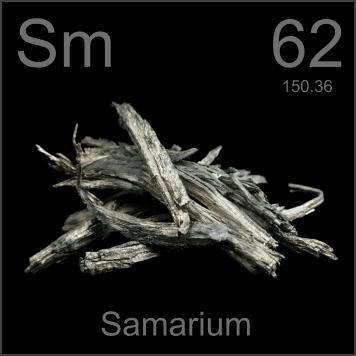Samarium is a yellowish rare earth element belonging to the lanthanide series of metals on the periodic table. Although samarium is similar in appearance and properties to most other metals, it has relatively fewer uses. A notable application of samarium is in the manufacture of very powerful magnets. Compounds of samarium are also used in television tubes and for coloring glass.
Samarium has an atomic number of 62, and is denoted by the symbol, Sm. In this piece, we’ll look at the important application of samarium, as well as the properties and occurrence and discovery of the element.
Occurrence of Samarium in Nature
Samarium is a naturally occurring element, much like several other elements that appear in the earth’s crust. Studies show that it is about as common as boron, thulium, and gadolinium (both of which are lanthanides). As with most other rare-earth elements, the primary sources of samarium are monazite and bastnasite minerals.
Samarium is also found in samarskite, cerite, orthite, ytterbite, and fluorspar. Samarium is generally regarded as an abundant lanthanide compared to other elements belonging to the same group. It is found in about 4.5-7 parts per million (ppm) in the earth’s crust.
Properties of Samarium
The study of samarium is followed by a long history which began in 1880, when French chemist Paul-Émile Lecoq de Boisbaudran was studying a substance known as Didymium. Boisbaudran believed that there were at least two new elements present in the didymium. Another French chemist called Jean-Charles-Galissard de Marignac, who was also studying didymium at the same time, was finally able to separate it into two parts, which he called didymium and samarium.

20 years after Marignac’s discovery, Eugène-Anatole Demarçay, another French chemist, discovered that samarium consisted of two parts, namely: samarium and europium. The name samarium, was taken from a mineral in which the substance occurs, samarskite which is actually the last name of a Russian mine official, Colonel Samarski.
- The element is yellowish in color
- Freshly prepared samarium has a silvery luster
- It has a boiling point of about 1,974 °C (3,262 °F) with a melting point of 1,072 °C (1,962 °F)
- It has a density of 7.53 grams per cubic centimeter.
- At ambient conditions, samarium has a rhombohedral structure (the α form).
- Samarium is one of the few lanthanides that exhibit oxidation state +2.
- It dissolves readily in dilute sulfuric acid to form solutions containing yellow to pale green samarium ions.
- Samarium is a fairly reactive metal. It is quite electropositive and reacts slowly with cold water and quickly with hot water, forming samarium hydroxide and releasing hydrogen gas.
- Samarium is the hardest and most brittle of the rare earth elements.
- It can combine with other substances under mild conditions.
Isotopes of Samarium
There are seven naturally-occurring isotopes of samarium. The are:
- Samarium-144 (3.1%)
- Samarium-147 (15.0%)
- Samarium-148 (11.2%)
- Samarium-149 (13.8%)
- Samarium-150 (7.4%)
- Samarium-152 (26.8%), and
- Samarium-154 (22.0 percent).
Samarium-144, samarium-150, samarium-152, and samarium-154 are stable, but the other three naturally occurring isotopes are radioactive alpha emitters. However, a total of 34 (excluding the nuclear isomers) radioactive isotopes of samarium have been characterized, with masses ranging from 128g to 165g. Their half-life ranges from 0.55 seconds for samarium-129 to 7×1015 years for samarium-148.
Uses of Samarium
- Samarium is used in combination with cobalt to make powerful samarium-cobalt magnets, which are stronger than iron magnets. These magnets do not lose their magnetism at high temperatures, making them suitable for application in microwave applications. They also made the miniaturization of electronic devices like headphones, and the production of personal stereos.
- Samarium sputtering targets and Samarium evaporation materials are used in deposition processes including semiconductor deposition, chemical vapor deposition (CVD) and physical vapor deposition (PVD).
- Like other lanthanides, samarium is also used in carbon arc lighting for studio lighting and projection.
- Samarium is also used in optical lasers to dope calcium chloride crystals.
- The element is used in infrared absorbing glass and as a neutron absorber in nuclear reactors.
- Samarium oxide is used in making glass and ceramics.
Conclusion
Samarium is a rare-earth metal belonging to the lanthanide series. It has high melting and boiling points, and is the most volatile lanthanide after ytterbium and europium. Samarium is fairly abundant in the earth’s crust and has seven naturally-occurring isotopes. Some of its most important applications are found in the manufacture of optical lasers, carbon arc lighting studios, and the production of samarium-cobalt magnets. For more information, please visit https://www.sputtertargets.net/.




